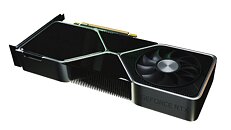Thursday, July 2nd 2020

NVIDIA GeForce "Ampere" GPUs Built on Samsung 8nm Instead of TSMC 7nm?
NVIDIA's upcoming GeForce "Ampere" family of GPUs will be built almost entirely on Samsung's 8 nanometer silicon fabrication process that's derived from its 10 nm node; rather than TSMC's 7 nm process, according to kopite7kimi, a source with a high hit-rate with NVIDIA rumors in the past. The 8LPP silicon fabrication node by Samsung is an extension of the company's 10LPP (10 nm) node. Both have the same fin pitch, but reductions are made in the areas of gate pitch (down by 6%) resulting in a transistor density of over 61 million/mm². Apparently NVIDIA's entire high-end product stack, including the GA102 silicon that powers at least three high-end consumer SKUs, are expected to be based on Samsung 8LPP.
Source:
kopite7kimi

65 Comments on NVIDIA GeForce "Ampere" GPUs Built on Samsung 8nm Instead of TSMC 7nm?
I say we will witness 10x density 10 years later compared to GF104.
Companies want and predict one thing, the customers decide another, hence you have AMD reporting red numbers in their fiscal reports for the RTG division group.
So, obviously, AMD's strategy and tactics simply don't work properly.
Till then, enjoy your lower tier SKU with a price bump.Lower tier cards provide the bulk of the profits, those GPUs that are faster than a 5700 XT are also more expansive.
Imagine having to explain this in 2020.
Now explain why Nvidia's Q1 2020 net income is close to $1B, while AMD's is miserable $160M ?
ir.amd.com/news-releases/news-release-details/amd-reports-first-quarter-2020-financial-results
www.globenewswire.com/news-release/2020/05/21/2037294/0/en/NVIDIA-Announces-Financial-Results-for-First-Quarter-Fiscal-2021.html
Your average consumers doesn't buy a 2080ti or a 2080, they buy 2060s/5700XTs and below. It would have hardly made any difference if AMD had a higher end card from the day the 5700XT was released, those aren't volume products.
All the other AMD cards as well. This results in much fewer sales for AMD and 5-6 times higher net income for Nvidia.
The 290X when it launched competed with the 780 in performance, and after the 290X launched nVidia quickly dropped the MSRP of the 780 to $50 less than the 290X even though they performed nearly exactly the same(unless you set the 290X to jet engine mode).
Expensive and fast != "prosumer"I don't know what you seek to argue about that it competed with the 780, both the 780 and Titan were the same chip with the 780 having 2 SMs disabled. For all intents and purposes AMD's 290X was performing similar to Nvidia's thousand dollar GPU. Anyway the point is that AMD did compete in the past quite well in the high end and they gained nothing from it, they learn't their lesson and are now focusing primarily to the mid range.That's perhaps because of your red and green tinted shades that you think that, plenty of people bought those. They were inexpensive and performed decently for their time, the 8xxx series were particularly popular.
What exactly were all those people up until 2017 buying ? AMD stickers ?Except they didn't, the 1800X was still slower than 6900K across the board, plus Intel had a 10 core CPU available at the time. The only reason they succeed was because of the performance/dollar, proving one again that halo products aren't what drives sales. Most people probably don't even know which are the fastest GPUs/CPUs out there, let alone lettings themselves being influenced somehow because of them. Again, that's how fanboys think.
And, hell, even nVidia one upped themselves. The 780Ti outperformed the 780, the 290X, and the Titan(even though they used the same chip) and was like $300 cheaper than the Titan.
But, the fact that you have to go back 7 years to get to a time that AMD even came close to competing kind of proves my original point though, doesn't it?
the Titan had f all worth for a gamer in USP, besides bragging rights and a bit of oomph.
Well, I thought Nvidia could have f'd the goose with Tsmc trying to get cheap chips, could be that they have really messed up here, or it could pan out fine, well see.
Ryzen 7 1800X scores 16,248 in PassMark, while Core i7-6900K only 14,478.
www.cpubenchmark.net/cpu.php?cpu=AMD+Ryzen+7+1800X&id=2966
www.cpubenchmark.net/cpu.php?cpu=Intel+Core+i7-6900K+%40+3.20GHz&id=2794